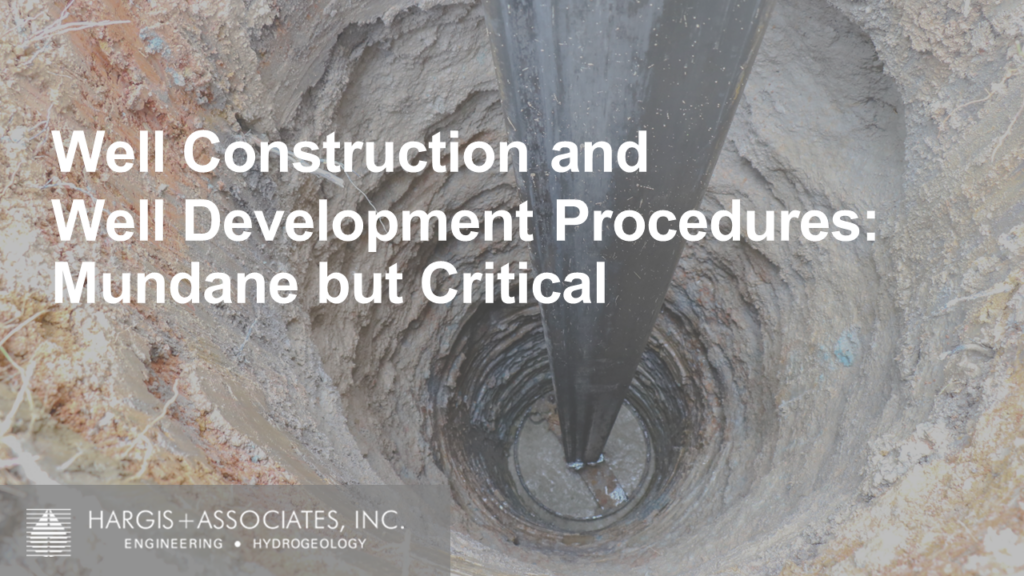Installing a large production well for municipal, industrial, or agricultural use is a significant investment of both time and money. The entire process from planning to full operation can range from a few months to over two years. In the western United States, production well installation typically costs hundreds of thousands to millions of dollars.
With so much at stake, it seems logical that one would ensure careful planning and execution throughout every stage from planning through full operation. Unfortunately, that isn’t always the case.
This blog is intended to help you avoid costly mistakes during the well construction and well development phases. I’ll examine why these final stages are often underestimated, the consequences of ignoring well construction and development details, and how to remedy problems should they arise.
Let’s start with a brief overview of the production well installation process.
Six Stages of Installing a Water Well
Installing a water well, especially for water supply, involves several key phases to ensure the well is both productive and sustainable. The exact phases can vary based on the specific application, location, geology, and regulatory environment, but a general sequence of six phases can be outlined as follows:
1. Selecting a Location
- Determine the purpose of the well (e.g., water supply, monitoring).
- Determine the depth, diameter, and location of the well.
- Secure necessary permits from local, state, or national regulatory bodies.
- Ensure all environmental regulations and water rights (if applicable) are considered.
2. Drilling
- Use a drill rig to bore a hole to the desired depth. The drilling method (e.g., rotary, sonic, auger, direct push) depends on the geology and the well’s intended use.
- Monitor the drilling process to identify water-bearing zones or hydrocarbon reservoirs.
3. Collecting Lithological & Geophysical Data
- Conduct hydrogeological or geophysical surveys to assess subsurface conditions.
4. Designing the Well System
- Design the well system, including the casing, screen, and pump.
5. Well Construction
- Place a casing (usually made of steel or PVC) in the borehole to support the well structure.
- Install a well screen in the production zone to allow water or hydrocarbons to enter the well while preventing sediment from getting in.
- Grout the annular space between the borehole and the casing to seal off non-productive zones and ensure protection from contamination.
6. Well Development and Testing
- Develop the well by pumping or surging water to remove fine sediments and improve well efficiency.
- Conduct pump tests to determine the well’s yield and drawdown characteristics.
- Collect water samples (for water wells) to test for water quality and ensure it meets standards.
Why are Well Construction and Well Development Overlooked?
These final stages of preparing a production well are often underestimated and ignored, yet can have a significant impact on well productivity, efficiency, operating cost, and useful lifespan of the well.
So why rush through these final stages?
Well construction and well development are considered simple mechanical tasks in the decision-making process. Without field experience or a technical background, well owners believe they can rely on basic standards or template specifications to get them into full operation. Many times these procedures are simply pulled from standard language, like the National Ground Water Association’s water well construction standard, that describes the types of materials to be used in construction, defines the method of installing the materials in a general sense (disregarding site specific conditions and intended applications), and includes a prescribed method and duration of well development.
What are the Consequences of Ignoring Well Construction and Development Details?
The fact that less attention and importance is placed on the construction and development procedures is a costly mistake. Well construction materials and procedures can impact the well’s structural integrity, productive characteristics, water quality, and ultimately, the cost per gallon of water and the lifecycle cost of the well.
Bridging of the Gravel Pack
A recent experience illustrates the issues that can arise from poor well construction procedures. In this instance, a large diameter production well was not appropriately prepared for gravel packing by thinning the drilling mud. Bridging of the gravel pack occurred.
Bridging is a phenomenon where the gravel particles, which are introduced around a well screen to prevent the migration of formation sands into the well, begin to accumulate or stack upon each other in such a way that they form a sort of “bridge” or blockage within the annulus between the borehole wall and the well screen.
This bridging can occur for several reasons:
- Improper Gravel Size: If the gravel’s grain size isn’t properly matched to the formation’s grain size, the gravel may not settle evenly and compactly, leading to bridging.
- Poor Placement Techniques: If the gravel is not placed evenly, or if it’s introduced too quickly, it can cause bridging.
- Formation Instabilities: If the formation around the borehole is not stable, it may collapse or shift in a way that causes the gravel to bridge.
Bridging is undesirable for a number of reasons:
- Reduced Well Efficiency: The bridge can impede the flow of water or hydrocarbons into the well, leading to reduced production rates.
- Incomplete Sand Control: The primary reason for introducing a gravel pack is to provide sand control – to prevent formation sands from migrating into the well. Bridging can result in gaps or voids in the gravel pack, defeating this purpose and allowing sand to enter the well, which can lead to operational issues and even damage to well components.
- Potential for Premature Well Failure: Inadequate gravel packing can compromise the structural integrity of the well over time, potentially leading to premature well failure.
In this case, the gravel pack shifted as much as 60 feet during the development process, causing the well casing to drop. This resulted in the deformation of the steel casing and the surface casing. If the casing landing supports had failed, the well could have been a complete loss.
A similar problem at another well occurred resulting in the well consistently producing a large amount of sand and silt through the zones that did not have gravel packed in the bridged zones. The remedy required many hours of redevelopment and the addition of significant amounts of gravel to cure the problems.
How to Remedy Poor Construction and Development
Well development procedures are as crucial as choosing the screen type, size, and the appropriate gravel/sand pack. The aforementioned issues were resolved by adequately diluting the drilling fluid during gravel packing and swabbing the well simultaneously to prevent bridging. Once correctly developed, these wells yielded minimal sand and silt, safeguarding the pumping equipment from excessive wear and subsequently lowering operating and maintenance costs.
Beyond the immediate steps taken to address the issues, continuous monitoring is pivotal in assuring the longevity and efficiency of the well. Overlooking small discrepancies in the initial phases can lead to cumulative adverse effects, potentially jeopardizing the entire system in the long run. It’s essential to adopt a proactive approach, routinely inspecting the construction and maintaining vigilance for signs of wear or inefficiencies.
Moreover, advances in technology and best practices are continually shaping the well construction and development landscape. Keeping abreast of these innovations not only ensures adherence to the highest industry standards but also harnesses the potential of newer, more efficient techniques. This can significantly amplify the efficacy of remedial measures, ensuring a seamless and productive operation for years to come.
Avoid Costly Mistakes During Final Completion of Your Water Well
In conclusion, well construction and development go beyond mere mechanical procedures. The success of drilling and constructing production wells hinges on choosing the right construction and development techniques tailored to each drilling method and geological setting. This calls for a deep understanding of not only the hydrogeologic landscape and well design but also the nuanced variations in construction and development processes.
It’s essential to involve hydrogeologists, engineers, and other experts throughout the process to ensure the well is safe, efficient, and sustainable.
For those venturing into production well construction, whether for municipal, industrial, or agricultural purposes, partnering with a seasoned consultant ensures adherence to best practices for optimal results.
For insightful guidance or support in planning and constructing efficient production wells, contact Hargis+Associates, Inc.
About the Author

Michael R. Long
Principal Hydrogeolgoist
Hargis+Associates, Inc.
mlong@hargis.com
Linkedin: https://www.linkedin.com/in/michael-r-long-486a1720/
Michael Long has professional experience in hydrogeology and geology since 1973. He is the former Chief Hydrologist and manager of the Basic Data Unit for the Arizona Department of Water Resources. As an environmental consultant, he has helped clients navigate the complex CERCLA and RCRA processes and mitigate risk through remedial investigations, feasibility studies, remedial action planning and implementation, monitoring, and the closure & delisting process at sites with groundwater, soil, and soil vapor contamination. Michael’s current professional responsibilities include directing technical operations in Arizona including management of offices, supervision of technical staff, project management involving water resource evaluation, hydrogeologic assessments, field investigations, groundwater permitting, and groundwater modeling. Areas of specialization include hydrogeologic assessments, groundwater resource evaluations, well and wellfield design and construction, aquifer testing, and development of field methods for testing, sampling, well drilling, and well abandonment.

